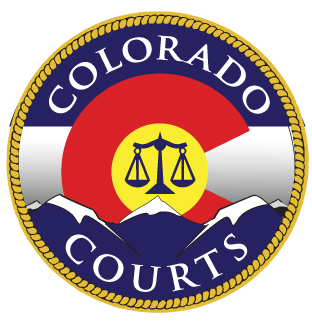Criminal Appeal Forms
Colorado Judicial Branch has compiled all forms required for Criminal Appeals.
About Criminal Appeals
An appeal is a request for a higher court to review a lower court's decision. When you start a county court criminal appeal, you are asking the district court to look at the decision that the judge made in your county court criminal case.
The reviewing court will look at your case file, your written arguments, and the transcripts from the case. There will not be a hearing or trial. You cannot give the court new evidence or subpoena witnesses.
For more information about county court criminal appeals, see Crim. P. 37 (Colorado Rules of Criminal Procedure). For more detailed instructions about filing an appeal, consult JDF 221 Instructions for County Court Criminal Appeals.
Criminal Appeal Filing Fees | |
|---|---|
| Appellant | See Filing Fees |
Felony Appeals
If you are appealing a felony criminal case that was in the district court, do not use these directions. Most felony criminal decisions are reviewed by the Colorado Court of Appeals.
For forms and instructions, see Appeals and Court of Appeals Forms and Policies.
Misdemeanor and Traffic Appeals
How to Start an Appeal
File in the same county that your case was heard. Use the courts locator to find the correct county court.
You have 35 days after the final decision to file the Notice of Appeal & Designation of Record. You must also order and pay for a transcript of the court hearing(s), and serve a copy of the forms to the District Attorney.
Forms and Paperwork Required
Use the forms link above to download and fill out JDF 222 Notice of Appeal and Designation of Record - Criminal and JDF 4 Transcript Request Form.
Paperwork Tips
Tips for completing JDF 222 Notice of Appeal and Designation of Record - Criminal:
- Each person in the appeal of the case should be listed on the forms in the same role that they had in the original case. For example, if you were the Defendant in the original case, you are also the Defendant on the Notice of Appeal and Designation of Record - Criminal form.
- Follow the prompts on the form to fill in the blanks on the Notice form. Use your original case number for now.
- If you are appealing the case, you are the Appellant and will be signing the forms as the Appellant.
- The Notice form tells the court and the District Attorney that you are filing an appeal. Make sure you fill in the Certificate of Mailing on the Notice, telling the court when you will mail a copy of the Notice to the District Attorney.
- The Designation of Record section on the form tells the clerk which paperwork and records from your original case should go to the judge looking at your appeal.
- Make 2 copies of this form, one for the county court and one for the district court. Each copy should have your original signature. Make a copy of the form for the District Attorney and send it to them by mail.
Tips for completing JDF 4 Transcript Request Form:
- Check with the court where you will be turning in your paperwork to see if a different Transcript Request form or process should be used.
- Fill in the blanks on the Transcript Request form, including the original case number and the person(s) involved in the case. Write on the form the dates of hearings that you would like to be transcribed and provided to the court.
- After you submit the form to the court, a transcriber (the person who creates the typed record of the hearings) will contact you. Make sure that your contact information on the form is correct. The transcriber will tell you how much it will cost to create the transcript. You must pay for the transcript or make arrangements to pay for the transcript before the transcriber will start working on it.
How to Submit Paperwork to the Court
- Decide where (which courthouse) to deliver your paperwork. Your case will be reviewed by the district court in the county where your case was heard. Use the courts locator to find the correct county court.
- Give the district court the completed forms. The district court is often in the same location as the county court. Ask a clerk for directions if you can't find the district court.
- Pay the filing fee, including the appeal bond.
- If you do not think you can afford the filing fee, fill out form JDF 205 Motion to File Without Payment and Supporting Financial Affidavit and JDF 206 Finding and Order Concerning Payment of Fees to request a waiver of the filing fee, or visit our File Without Payment section for complete information.
- Pay the appeal bond with cash or certified funds. The appeal bond is usually set by the judge that heard your original case.
- Give a copy of the paperwork to the county court that decided your case.
- Mail a copy of the Notice of Appeal and Designation of Record to the District Attorney.
About Briefs
You make your arguments for the appeal by providing the reviewing court with a written argument called a Brief.
Once the district court receives the record from the county court, you will have 21 days to give a written Opening Brief to the court. The Brief tells the higher court exactly what you want reviewed in your appeal and the legal mistakes you believe the judge in the lower court made, including any arguments and law that support what you say.
How to Write an Opening Brief
- Write an Opening Brief.
- You may want to visit your local library or a law library to look at examples of Opening Briefs for county court criminal appeals.
- An Opening Brief form is not available. You may want to look at JDF 76 General Motion to make sure that you have a caption, are using the correct font type, and are using the correct font size on the Opening Brief that you create. C.R.C.P. 10 (Colorado Rules of Civil Procedure) includes the format requirements for Briefs.
- Decide where (which courthouse) to deliver your Opening Brief. Your appeal case is in the district court in the county where the original case was started. Use the courts locator to find the correct court.
- Give the court the completed Opening Brief.
- Mail a copy of the Opening Brief to the other person in the case, or their attorney.
- Complete JDF 1313 Certificate of Service, telling the court how you provided a copy of the Opening Brief to the District Attorney.
- Give the completed JDF 1313 to the court.
How to Respond to the District Attorney
The District Attorney may give an Answer Brief to the court. You should receive a copy of the Brief. The District Attorney will respond to what you said in your Brief and bring up any other issues that they think are important. The District Attorney must give a copy of their Answer Brief to the court within 21 days after you give them a copy of your written Opening Brief.
You may respond to the District Attorney's Answer Brief with a Reply Brief. You will have 14 days from the time you receive the District Attorney's Answer Brief to file your Reply Brief. In your Reply Brief, respond to any new points that the District Attorney made in their Answer Brief. Include any arguments and law that support what you say.
How to Write a Reply Brief
- Write a Reply Brief.
- You may want to visit your local library or a law library to look at examples of Reply Briefs for county court criminal appeals.
- An Reply Brief form is not available. You may want to look at JDF 76 General Motion to make sure that you have a caption, are using the correct font type, and are using the correct font size on the Reply Brief that you create. C.R.C.P. 10 (Colorado Rules of Civil Procedure) includes the format requirements for Briefs.
- Decide where (which courthouse) to deliver your Reply Brief. Your case is in the district court where the original case was located. Use the courts locator to find the correct court.
- Give the court the completed Reply Brief.
- Mail a copy of the Reply Brief to the District Attorney.
- Complete JDF 1313 Certificate of Service, telling the court how you provided a copy of the Reply Brief to the District Attorney.
- Give the completed JDF 1313 to the court.
What Happens Next?
Once all of the deadlines have passed for giving paperwork to the court, such as Briefs, Answer Briefs, etc., the district court judge will look at the case file and transcript. No new hearing will be held. The district court judge will create a written ruling or order.
You and the District Attorney will receive a copy of the ruling or order. After final ruling or order on the appeal by the district court judge, the judgment on appeal will be sent to the county court for action as directed by the district court judge. The court will release/disburse the appeal bond based on the ruling of the district court.
Appealing the Ruling Court's Decision
It may be possible to appeal the ruling court's decision. You can ask the Colorado Supreme Court if they would grant an additional review. This review is called a Petition for Writ of Certiorari.
You must submit your request within 42 days of the decision. If your request for an additional review is granted, the Supreme Court will notify you with more information.
 Colorado Judicial Branch
Colorado Judicial Branch
